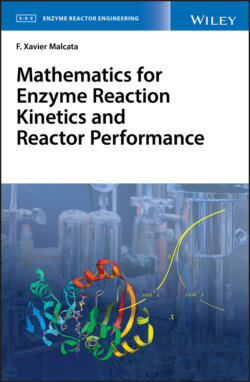Читать книгу Mathematics for Enzyme Reaction Kinetics and Reactor Performance - F. Xavier Malcata - Страница 45
4.2 Multiplication of Scalar by Matrix
ОглавлениеGiven a generic scalar, say, α, another operation can be defined encompassing matrix B of any type, viz.
(4.20)
with the aid of Eq. (4.3); this is termed multiplication of scalar by matrix. In view of Eqs. (4.3) and (4.20), one has that
(4.21)
which may be rewritten as
(4.22)
due to the commutativity of addition of scalars – or, upon use of Eq. (4.20) backward,
(4.23)
Eq. (4.3) may again be recalled to write
(4.24)
known as commutative property of multiplication of scalar by matrix – even though the scalar is normally placed up front relative to the matrix, for a matter of convention.
If a second scalar is invoked, say, β, then Eq. (4.9) supports
(4.25)
where application of Eq. (4.20) unfolds
(4.26)
a second application of Eq. (4.20) yields
(4.27)
together with the associative property of multiplication of scalars. Final backward application of Eq. (4.20) gives rise to
(4.28)
or, equivalently,
(4.29)
due to Eq. (4.9); one usually refers to Eq. (4.29) as associative property.
If addition of matrices and multiplication of scalar by matrix are considered simultaneously, then one gets
(4.30)
as per Eqs. (4.3) and (4.9), with Eq. (4.4) supporting transformation to
(4.31)
Equation (4.20) may now be invoked to write
(4.32)
complemented with the distributive property of multiplication of scalars – where application of Eqs. (4.4) and (4.20) leads to
(4.33)
or, once Eqs. (4.3) and (4.9) are taken into account,
(4.34)
Therefore, multiplication of scalar by matrix is distributive, with regard to addition of matrices.
One may conceive a similar property encompassing addition of scalars, i.e.
(4.35)
as per Eq. (4.9) – which becomes
(4.36)
owing to Eq. (4.20), coupled with the distributive property of multiplication of plain scalars. Reverse application of Eq. (4.4) leads to
(4.37)
and an extra utilization of Eq. (4.20) entails
(4.38)
– or else
(4.39)
at the expense of Eq. (4.9). Based on Eq. (4.39), one realizes that multiplication of scalar by matrix is distributive also with regard to addition of scalars.
A final property pertains to product of (scalar) unity by a matrix, according to
(4.40)
based on Eq. (4.2); application of Eq. (4.20) permits, in turn, transformation to
(4.41)
Since 1 is the neutral element of multiplication of scalars, Eq. (4.41) can be redone as
(4.42)
that is equivalent to
(4.43)
in view again of Eq. (4.2) – thus leaving the matrix unchanged, whatever it is; 1 is accordingly confirmed as the neutral element of multiplication of scalar by matrix.
When the scalar at stake is −1, its product by matrix A transforms every element thereof to its negative; the result, usually denoted as −A, looks like
(4.44)
as per Eqs. (4.2) and (4.20). Matrix −A is called symmetric of A – because addition of those two matrices produces a nil matrix, i.e.
(4.45)
at the expense of Eqs. (4.2), (4.4), and (4.44).
